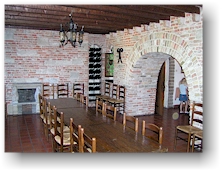|
» Altena castle » Waterhoek chapel » Sarepta chapel » Moerkerke church » Barrel canon WWII » Mon. battle "Molentje" » Leopoldcanal » Schipdonkcanal » Castle Ryckevelde » Castle of Oostkerke » Altena castle |
Castle of Moerkerke
After belonging to the family "van Moerkerke", the castle passed on to the family "van Praet". This last family is an old, very important noble family (see also Oedelem). In the 16th century, the stronghold was then sold by this family. After having belonged to a number of other noble families, it was inhabited by the friars Xaverians in 1922 who sold it some decades later to colonel van den Broeck. The castle went through a large number of reconstructions. The first castle constisted of a central, square tower (donjon) that was erected on an artificial hill and a main court. The donjon was the defensive unit and was faced towards the sea. The tower was accessible via a drawbridge. In the crypt you can still see traces from that era. During the uprising of the Flemish count against the French king, the nobles at the castle of Moerkerke, supported the French crown. In 1302, on the farm "Groene Hoeve" (situated in Den Hoorn) a conspiracy was plotted against the "French" castle. The result is that the castle was set on fire. At the end of the 14th century the stronghold fell prey to raiding militia from Ghent.
At the end of the 16th century, Clemens of Castilla, a Spanish aristocrat, bought the residence. Due to the new weapons and war techniques, castles started losing their defensive nature and many of them are transformed into pleasance mansions. This is also what Clemens of Castilla did with Moerkerke castle. The domain received a thorough renovation but was sold a few years later to a wealthy merchant from Bruges.
Through marriage, the property passed on to the noble family 't Serclaes de Wommersom, who in their turn radically renovated the castle too. The chateau received its actual appearance in 1912 but then experienced a period of decay. When Colonel Van den Broeck bought it in 1964 it was nothing more than a ruin. Under his impulse it was tastefully restored and extended with a left and right wing. Interesting to know: there still is an icehouse in the the left wing and there is a beautiful garden with pond. Nowadays, the castle is a very popular place for parties and weddings.
|
|
 Location:
Kasteelstraat 7, 8340 Moerkerke [gps]
Location:
Kasteelstraat 7, 8340 Moerkerke [gps] One
of the most well-known residents was Charles of Saint-Omaars.
He lived here in the 16th century and was one of the most
important botanists at that time. He designed one of the
first and most beautiful botanical gardens in the region.
He also left us a unique collection of water-colour paintings.
One
of the most well-known residents was Charles of Saint-Omaars.
He lived here in the 16th century and was one of the most
important botanists at that time. He designed one of the
first and most beautiful botanical gardens in the region.
He also left us a unique collection of water-colour paintings.
 In
1700, Pierre de la Vilette, acquired the domain but he remained childless and 16
years later the castle passed on to Philippe François d'Hanins.
The domain staid in the family d'Hanins for quite some time.
In the 19th century they renovated the castle in neoclassical
style, common for that period.
In
1700, Pierre de la Vilette, acquired the domain but he remained childless and 16
years later the castle passed on to Philippe François d'Hanins.
The domain staid in the family d'Hanins for quite some time.
In the 19th century they renovated the castle in neoclassical
style, common for that period. 